Hobbyist Game Dev.
 Unity 3D
Unity 3DGame Development

 GPL Quake
GPL QuakeMod. Development

© Copyright 2001-2014
Pat AfterMoon

Copyrightdeposit.com
 Unity 3D
Unity 3D
 GPL Quake
GPL Quake


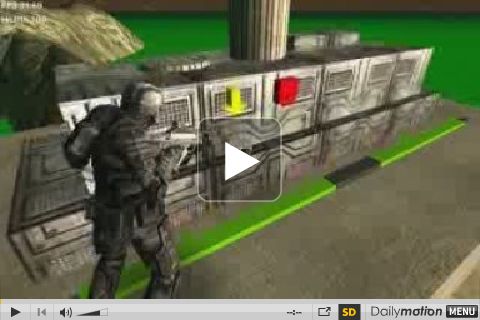
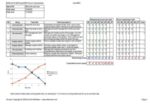 The 3rd sprint of the development of coopordie2 has been completed. The acid sea
tide has been basically implemented. The player is hurt by the acid, but if he
can get some rest, his health points are progressively restored. If the health
goes to zero, the player is forced to crouch, can't attack and can only
move slowly to a healing station. The healing station can treat the player
completely in a dozen seconds. During this last sprint I started to use the
Proto Pack
from Frogames. I have used it for the healing station model and particles
effect. Previously, using complex models for the player and monster was
interesting for my knowledge of the Unity engine asset integration.
The 3rd sprint of the development of coopordie2 has been completed. The acid sea
tide has been basically implemented. The player is hurt by the acid, but if he
can get some rest, his health points are progressively restored. If the health
goes to zero, the player is forced to crouch, can't attack and can only
move slowly to a healing station. The healing station can treat the player
completely in a dozen seconds. During this last sprint I started to use the
Proto Pack
from Frogames. I have used it for the healing station model and particles
effect. Previously, using complex models for the player and monster was
interesting for my knowledge of the Unity engine asset integration.
 But for rapid prototyping and testing the game play, I will probably not
pay too much attention to the models for the next sprints. I plan to use the proto Pack
again for a quick implementation of the mine shaft.
But for rapid prototyping and testing the game play, I will probably not
pay too much attention to the models for the next sprints. I plan to use the proto Pack
again for a quick implementation of the mine shaft. There is also an aspect of the Scrum method that I would try for my development; it
is a sprint review meeting.
I think I could provide a demo
at the end of the next sprint. It could be a game play video, or directly a
release of the game in its current state. I could put it online for a short
time and organize a sort of development chat with some friends and coopordie
visitors. Creating an event, showing the product and chatting with other people
will probably help with maintaining the pressure on me. The synthesis of the
discussion may help me to do a sprint retrospective. All in all, the
experience will probably be interesting. For preparing this demo event I will
share more information about the next sprint and I will soon open a new forum
dedicated to coopordie2.
There is also an aspect of the Scrum method that I would try for my development; it
is a sprint review meeting.
I think I could provide a demo
at the end of the next sprint. It could be a game play video, or directly a
release of the game in its current state. I could put it online for a short
time and organize a sort of development chat with some friends and coopordie
visitors. Creating an event, showing the product and chatting with other people
will probably help with maintaining the pressure on me. The synthesis of the
discussion may help me to do a sprint retrospective. All in all, the
experience will probably be interesting. For preparing this demo event I will
share more information about the next sprint and I will soon open a new forum
dedicated to coopordie2.
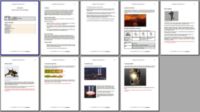 Here it is, I have been working seriously on a COOP or DIE 2
prototype for the last two months. For this new project I would like to experiment an agile approach
like the one described by Peter Bell in his
Solo Scrum article.
I'm completely new to
Scrum,
but I could probably become familiar with some of its concepts by using it
for this spare time activity.
Here it is, I have been working seriously on a COOP or DIE 2
prototype for the last two months. For this new project I would like to experiment an agile approach
like the one described by Peter Bell in his
Solo Scrum article.
I'm completely new to
Scrum,
but I could probably become familiar with some of its concepts by using it
for this spare time activity.
 So, it is a game prototype planned to be developed from July to December 2009 at an
average of 10 hours per week. I think I have defined the prototype as something basic
and doable.
So, it is a game prototype planned to be developed from July to December 2009 at an
average of 10 hours per week. I think I have defined the prototype as something basic
and doable.
 The tools are chosen and most of the art content has already been acquired.
I have firstly written a user manual
which explains most of the elements. I have
also written a first draft of product backlog and sketched the first 3 sprints of 2
weeks each. I'm currently running the third sprint.
The tools are chosen and most of the art content has already been acquired.
I have firstly written a user manual
which explains most of the elements. I have
also written a first draft of product backlog and sketched the first 3 sprints of 2
weeks each. I'm currently running the third sprint.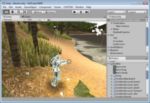 I have now used Unity3D for the last 4 months and I really enjoy it. From what I've
currently experienced, the engine is powerful enough for my needs and the
development tool is fun to use. I've found the scripting part relatively
simple and coherent for implementing what I've needed so far. The fact that
multiple scripting languages are allowed is a little disturbing at first. For
now, I can't say if I prefer the simplicity of the javascript syntax or the rigor
of the C#. As I use and modify a lot of existing resources, I take them as
they come.
I have now used Unity3D for the last 4 months and I really enjoy it. From what I've
currently experienced, the engine is powerful enough for my needs and the
development tool is fun to use. I've found the scripting part relatively
simple and coherent for implementing what I've needed so far. The fact that
multiple scripting languages are allowed is a little disturbing at first. For
now, I can't say if I prefer the simplicity of the javascript syntax or the rigor
of the C#. As I use and modify a lot of existing resources, I take them as
they come.
 So the result is a mix of the 2 languages, a situation that will
probably need to be settled in the future. The integration of art assets is
clearly the place where Unity3D shines the most. After years of Quake2, Quake3,
Doom3 and Torque engine, it is as if I have entered a new world. As far as I
can remember, it was never so easy to take a 3D model character and integrate
it in a game prototype. In addition, the way the Unity3D editor works suits
an incremental approach perfectly. I can add feature after feature, and test
the game continually.
So the result is a mix of the 2 languages, a situation that will
probably need to be settled in the future. The integration of art assets is
clearly the place where Unity3D shines the most. After years of Quake2, Quake3,
Doom3 and Torque engine, it is as if I have entered a new world. As far as I
can remember, it was never so easy to take a 3D model character and integrate
it in a game prototype. In addition, the way the Unity3D editor works suits
an incremental approach perfectly. I can add feature after feature, and test
the game continually.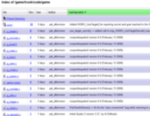 Since last week-end I have started to fill the
coopordiequake2 SVN
at SourceForge.
The repository was initialized with the id Software Quake 2 GPL source code
version 3.21.
I have committed the code and data for the coopordie
0.6
version from February 13, 2008. I have also added few small changes I'd already
made and that will be released on the next version.
Since last week-end I have started to fill the
coopordiequake2 SVN
at SourceForge.
The repository was initialized with the id Software Quake 2 GPL source code
version 3.21.
I have committed the code and data for the coopordie
0.6
version from February 13, 2008. I have also added few small changes I'd already
made and that will be released on the next version. It's funny, but while searching information about the Torque3D web capabilities, I've
discovered one of its competitors. Unity3D
has a very different approach, targeted more at content creators and web
developers than traditional coders. It seems to fill the gap between Adobe Shockwave
3D and the Torque Game Engine. I hadn't noticed Unity3D before. It was mainly
because even though it can produce games for Mac and MS-Windows, the developers' tools
were only available for Mac. Since the recent
version 2.5
this bug has been corrected
It's funny, but while searching information about the Torque3D web capabilities, I've
discovered one of its competitors. Unity3D
has a very different approach, targeted more at content creators and web
developers than traditional coders. It seems to fill the gap between Adobe Shockwave
3D and the Torque Game Engine. I hadn't noticed Unity3D before. It was mainly
because even though it can produce games for Mac and MS-Windows, the developers' tools
were only available for Mac. Since the recent
version 2.5
this bug has been corrected
 Since the start of 2006 I have stopped using the Torque Game engine.
But I've always kept an eye on GarageGames.
The interaction between a game and a website has always interested me, so I've
watched their web portal InstantAction
since the closed beta version. It seems that web integration for games is very popular
these days, and not only for traditional casual games. I'm impatient to see what
the next QuakeLive will be.
Currently the web part of these projects is mainly related to game account,
player profile, chat and game lobby. But I'm sure some new features will start to
appear with this different way of playing games.
Since the start of 2006 I have stopped using the Torque Game engine.
But I've always kept an eye on GarageGames.
The interaction between a game and a website has always interested me, so I've
watched their web portal InstantAction
since the closed beta version. It seems that web integration for games is very popular
these days, and not only for traditional casual games. I'm impatient to see what
the next QuakeLive will be.
Currently the web part of these projects is mainly related to game account,
player profile, chat and game lobby. But I'm sure some new features will start to
appear with this different way of playing games.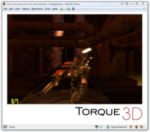 After asking the GarageGames team about InstantAction technology licensing I
learned that their new Game Engine Torque3D will support basic
web publishing options.
Playing a Torque-based game inside a web browser with easy web interaction is
plenty enough to convince me. But there are lots of other interesting features. The
videos
from the last Game Developers Conference have finally convinced me. So I've
decided to take a more dept look and I've pre-ordered Torque3D.
After asking the GarageGames team about InstantAction technology licensing I
learned that their new Game Engine Torque3D will support basic
web publishing options.
Playing a Torque-based game inside a web browser with easy web interaction is
plenty enough to convince me. But there are lots of other interesting features. The
videos
from the last Game Developers Conference have finally convinced me. So I've
decided to take a more dept look and I've pre-ordered Torque3D.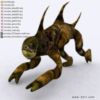 One of the things that has really pleased me while coming back to the Torque
community is the presence of 3DRT.com.
I've always been a fan of Max Shelekhov 3D modeling, and I've purchased several
models from him in the past. Seeing his interest towards Torque game developers was
very cool. All his recent productions are available on DTS format. Having high
quality models directly on the native animated models format of Torque Game Engine is a
nice additional advantage. That probably predicts a future interest on my part.
One of the things that has really pleased me while coming back to the Torque
community is the presence of 3DRT.com.
I've always been a fan of Max Shelekhov 3D modeling, and I've purchased several
models from him in the past. Seeing his interest towards Torque game developers was
very cool. All his recent productions are available on DTS format. Having high
quality models directly on the native animated models format of Torque Game Engine is a
nice additional advantage. That probably predicts a future interest on my part.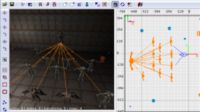 The Doom 3 Boss contest
is over. My contribution is modest, but I've reached one
of my goals: I've learned a lot!
My Imp Boss
is a sort of super Archvile with multiple waves of minions.
The Doom 3 Boss contest
is over. My contribution is modest, but I've reached one
of my goals: I've learned a lot!
My Imp Boss
is a sort of super Archvile with multiple waves of minions. At the end, I discovered an updated
bug free version,
with nearly the same corrections as mine
At the end, I discovered an updated
bug free version,
with nearly the same corrections as mine